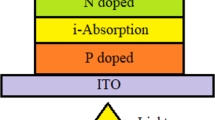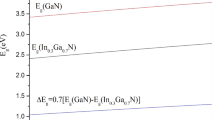Abstract
Despite the improvements seen in efficiency of GaAs cells over the years, there remains room for improvement for it to approach the theoretical single junction limit posited by Shockley and Quiesser decades ago. One of the more pursued options is the growth of quantum wells within the structure of GaAs to enhance its photon absorption below its bandgap. Multiple Quantum Wells (MQW) have been an ongoing topic of research and discussion for the scientific community with structures like InGaAs/GaAs and InGaP/GaAs quantum wells producing promising results that could potentially improve overall energy conversion. Here, we used WEIN2K, a commercial density functional theory package, to study the ternary compound Ga1-xTlxAs and determine its electronic properties. Using these results combined with experimental confirmation we extend these properties to simulate its application to form a MQW GaAs/ Ga1-xTlxAs solar cell. Ga1-xTlxAs is a tunable ternary compound, with its bandgap being strongly dependent on the concentration of Tl present. Concentrations of Tl as low as 7% can reduce the bandgap of Ga1-xTlxAs to roughly 1.30 eV from GaAs’s 1.45 eV at room temperature with as little as a 1.7% increase in lattice constant. The change in bandgap, accompanied by the relatively small change in lattice constant makes Ga1-xTlxAs a strong candidate for a MQW cell with little to no strain balancing required within the structure to minimize unwanted defects that impede charge collection within the device. Our GaAs photodiode with TlGaAs MQWs shows an expanded absorption band and improved conversion efficiency over the standard GaAs photovoltaic cell with dilute concentrations of Tl incorporated into the compound.
Similar content being viewed by others
References
J. P. Connolly et al., “Optimisation of High Efficiency AlxGa1-xAs MQW Solar Cells {[}arXiv],” in arXiv, 2016, no. October 2018, p. 12 pp.
H. Ohtsuka, T. Kitatani, Y. Yazawa, and T. Warabisako, “Numerical prediction of InGaAs/GaAs MQW solar cell characteristics under concentrated sunlight,” Sol. Energy Mater. Sol. Cells, vol. 50, no. 1–4, pp. 251–257, 1998.
R. Dahal, B. Pantha, J. Li, J. Y. Lin, and H. X. Jiang, “InGaN/GaN multiple quantum well solar cells with long operating wavelengths,” Appl. Phys. Lett., vol. 94, no. 6, pp. 2009–2011, 2009.
N. Watanabe, M. Mitsuhara, H. Yokoyama, J. Liang, and N. Shigekawa, “Influence of InGaN/GaN multiple quantum well structure on photovoltaic characteristics of solar cell,” Jpn. J. Appl. Phys., vol. 53, no. 11, pp. 1–9, 2014.
J. S. Roberts et al., “Photovoltaic characterisation of GaAsBi/GaAs multiple quantum well devices,” Sol. Energy Mater. Sol. Cells, vol. 172, no. July, pp. 238–243, 2017.
H. M. A. Mazouz, A. Belabbes, A. Zaoui, and M. Ferhat, “First-principles study of lattice dynamics in thallium-V compounds,” Superlattices Microstruct., vol. 48, no. 6, pp. 560–568, 2010.
M. Van Schilfgaarde, A. B. Chen, S. Krishnamurthy, and A. Sher, “InTlP - A proposed infrared detector material,” Appl. Phys. Lett., vol. 65, no. 21, pp. 2714–2716, 1994.
S. Krishnamurthy, A. B. Chen, A. Sher, and A. Sher, “Near band edge absorption spectra of narrowgap III–V semiconductor alloys,” vol. 4045, 1996.
M. Takushima et al., “Thallium incorporation during TlInAs growth by low-temperature MBE,” J. Cryst. Growth, vol. 301–302, no. SPEC. ISS., pp. 117–120, 2007.
Y. Kajikawa, N. Kobayashi, and H. Terasaki, “Limits in growing TlGaAs/GaAs quantum-well structures by low-temperature molecular-beam epitaxy,” Mater. Sci. Eng. B Solid-State Mater. Adv. Technol., vol. 126, no. 1, pp. 86–92, 2006.
Y. Kajikawa et al., “Effect of Tl content on the growth of TlGaAs films by low-temperature molecular-beam epitaxy,” J. Appl. Phys., vol. 93, no. 3, pp. 1409–1416, 2003.
K. Schwarz and P. Blaha, “Solid state calculations using WIEN2k,” vol. 28, pp. 259–273, 2003.
F. Tran, R. Laskowski, P. Blaha, and K. Schwarz, “Performance on molecules, surfaces, and solids of the Wu-Cohen GGA exchange-correlation energy functional,” Phys. Rev. B, vol. 75, no. 115131, pp. 1–14, 2007.
H. Asahi, H. Koh, K. Takenaka, K. Asami, K. Oe, and S. Gonda, “Gas source MBE growth and characterization of TlInGaP and TlInGaAs layers for long wavelength applications,” vol. 202, pp. 1069–1072, 1999.
H. Asahi, H. Koh, K. Takenaka, K. Asami, K. Oe, and S. Gonda, “Gas source MBE growth and characterization of TlInGaP and TlInGaAs layers for long wavelength applications,” J. Cryst. Growth, vol. 201, pp. 1069–1072, 1999.
Y. Arakawa, H. Sakaki, M. Nishioka, J. Yoshino, and T. Kamiya, “Recombination lifetime of carriers in GaAs-GaAlAs quantum wells near room temperature,” Appl. Phys. Lett., vol. 46, no. 5, pp. 519–521, 1985.
A. Mukhtarova et al., “Dependence of the photovoltaic performance of pseudomorphic InGaN/GaN multiple-quantum-well solar cells on the active region thickness,” Appl. Phys. Lett., vol. 108, no. 16, 2016.
Author information
Authors and Affiliations
Corresponding author
Rights and permissions
About this article
Cite this article
Zayan, A., Vandervelde, T.E. GaTlAs Quantum Well Solar Cells for Sub-band Gap Absorption. MRS Advances 4, 2015–2021 (2019). https://doi.org/10.1557/adv.2019.334
Published:
Issue Date:
DOI: https://doi.org/10.1557/adv.2019.334




